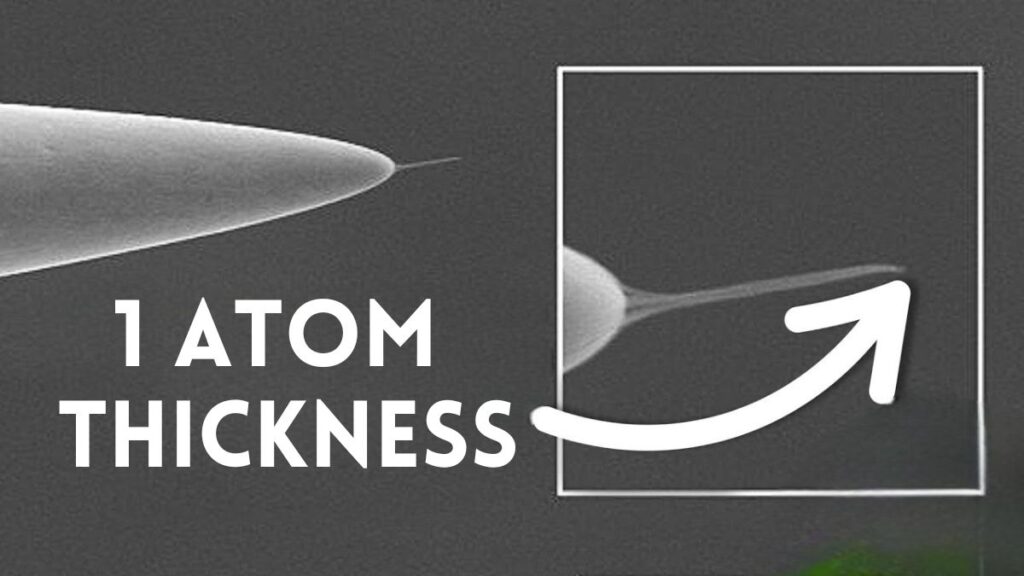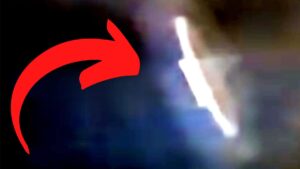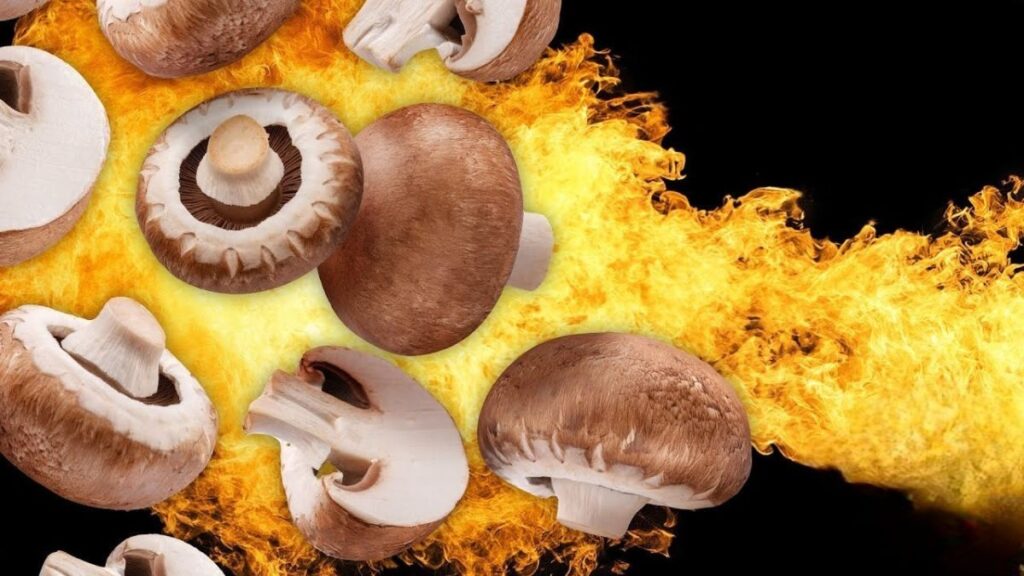
The world’s sharpest object cannot be used to cut anything, according to some arguments.
Which seems odd, doesn’t it?
Sharpness should come as no surprise to anyone who has ever sewn a badge or sliced an apple with a knife.
A sharp instrument cuts.
Right?
However, as with the majority of other things, scientists have attempted to establish a method for evaluating sharpness.
The odd thing is that they haven’t come up with a universal method!
Depending on the task at hand, sharpness can be defined in a variety of ways.
In addition, those things may be significant procedures, including scientific research and surgery.
In addition, our search for better tools has recently resulted in some of the sharpest objects we have ever produced, despite the fact that no one can agree on the precise method for measuring it.
Let’s start with the first thing that probably comes to mind when you hear the word “sharp” before we get to the world’s sharpest object. a knife’s handle.
Part of the explanation it stands out as such a striking model is the unmistakable state of an edge.
As a starting point for defining sharpness, we examine the precise details of that shape as well as its geometric properties.
Most of the time, a blade’s two sides are straight and flat.
Additionally, the intersection of the two sides resembles a wedge when we zoom in to the very edge.
The “sharpness” of the wedge appears intuitively to be based on two main properties: how sharply it points and how small it is.
In an effort to define sharpness, scientists have therefore developed specific measures of “pointiness” and “narrowness.”
Starting with the first, the wedge’s tip does not shrink to an infinitely small point when we zoom in on the blade’s “apex.”
Instead, it has a small curve at the end.
Imagine that curve as a segment of a circle.
The tightness of the curve, which ultimately determines how small a blade’s edge is, can be determined by the radius of that circle.
This is referred to as the edge radius, and it is the geometric term used to describe a knife’s “pointiness.”
A tighter curve that is closer to the ideal, perfectly pointy shape is achieved by reducing the edge radius.
However, the sharpness of a blade is not only determined by its edge radius; even blades with the same radius can be thicker or thinner.
Therefore, in order for “edge-radius” to be useful, we must first identify the “narrowness” component.
The wedge angle is used to define that: the angle that exists between the wedge’s two flat sides.
A more modest point implies a more slender wedge, which typically implies a more honed edge.
All of this means that defining sharpness using edge radius is only useful when the wedge angle is small.
In practice, this indicates that the objects we refer to as “blades” typically have wedge angles of around 20 degrees or less.
The edge radius is a useful starting point for determining sharpness in the event that we do have a small wedge angle.
For instance, the sapphire blades of some surgical scalpels have an edge radius of just 25 nanometers, or a few hundred atoms in width!
Due to the extremely precise and clean cuts it makes in the skin, sapphire scalpels actually heal their scars more quickly than steel scalpels do.
In addition, being made of hard sapphire and every one of, the edges are likewise really solid.
However, even these extremely sharp scalpels are not cutting edge.
Obsidian blades, a type of volcanic glass that can be shaped into an edge with a radius of just 3 nanometers across, hold that title.
It is one of the sharpest objects we are aware of in terms of edge radius because it is only a few dozens of atoms thick.
Amazingly, since the Stone Age, we have been using these sharpest tools as a species!
Additionally, obsidian blades are still utilized in some forms of surgery due to their extreme sharpness, which enables them to make cuts without requiring a great deal of pressure.
This is helpful when working on a part of the body that is very delicate and filled with fluid, like the eye, where we don’t want to poke too hard!
In fact, obsidian blades are so razor-sharp that they can even shatter individual cells.
Therefore, the combination of edge radius and wedge angle pretty accurately describes obsidian’s incredible cutting power.
Therefore, you might assume that defining sharpness is fairly straightforward.
Sadly, there are some flaws in the geometric properties we’ve discussed thus far.
For instance, describing the sharpness of pins and needles, which are also quite sharp!
We could use a radius, just like we did for blades, because their tips also point.
However, they lack the two flat sides of a blade, so the wedge angle doesn’t really make sense here.
We can utilize additional angles, but each has its own set of drawbacks.
The “bevel” angle is the angle that exists between the straight edge of the needle and the slanted bit at the very tip of hypodermic needles, for instance.
A sharper needle might be implied by a larger bevel angle.
The odd thing is that this is not always the case.
According to a 2012 study published in the Journal of Diabetes Science and Technology, the ability of a single needle to pierce skin with multiple bevel angles is essential for making them less painful and more effective.
In terms of sharpness, edge radius is not always the most sensible approach.
For instance, a tungsten nanoneedle developed by researchers at the University of Alberta holds the record for the smallest radius on a man-made tool.
A super-slender design delivers a small electrical flow that leaps between the needle and a surface.
The needle tip is able to do this by determining the positions of individual atoms on the surface, enabling us to construct a picture of the material’s appearance.
And the width of that tip is, wait for it, only one atom.
That is the pinnacle of tiny!
The tungsten nanoneedle was named the world’s sharpest human-made object by the Guinness Book of World Records due to its ridiculously small radius.
Which is cool and all, yet as we said in the first place, there is one little issue: Nothing can be cut or pierced with the needle!
Super “sharpness,” if we can call it that, does not increase the needle’s cutting or poking power because, as you might expect, something only one atom thick is extremely brittle.
When we tried to put any pressure on it, it would snap.
That isn’t only an issue with tungsten nanoneedles.
Because they are also brittle and pose a risk of breaking apart if a surgeon isn’t careful, even the surgical scalpels made of obsidian, which we mentioned earlier, aren’t used all the time.
Therefore, the wedge angle and edge radius are only part of the story behind sharpness when it comes to how simple it is to cut or pierce something.
They only talk about the object’s geometry, not how it works.
Actually, we can turn this around and think of sharpness as how easy it is to cut something, which gives us a mechanical definition.
More specifically, the amount of force required to cut something can be used to define sharpness.
For instance, the obsidian scalpels that we mentioned required less pressure to cut skin than a conventional steel scalpel, and this property is also present in other blades.
In a 2007 study, researchers at University College Dublin attempted to measure the depth at which a blade must “poke” into a material before initiating a cut to determine its sharpness.
The researchers demonstrated that distance is a reflection of the force required to cut with a blade.
A sharp blade is basically one that only requires a small amount of pressure and not much force.
When we consider sharp knives in the context of activities like cooking, this makes a lot of sense.
Even better, the same researchers discovered a correlation between this alternative definition of sharpness and the familiar geometric properties of blades.
The wedge angle and edge radius definitions of sharpness are linked to a lower force required to cut with a given blade, according to other studies.
That includes the tools from the Stone Age that we discussed earlier.
Stone tools with a smaller edge radius required less mechanical force to cut a PVC pipe, according to a 2022 study led by an archaeologist at the University of Cambridge.
Therefore, the geometric and mechanical definitions of sharpness make sense, at least for stone tools.
Yet, regardless of whether we utilize the two definitions, there’s as yet something missing from our image of sharp instruments.
It just so happens, the mechanical power expected to cut a material relies upon what that material is!
We cannot solely concentrate on the tool itself.
This was demonstrated by Italian researchers at the University of Parma in 2018 using a sharpness measure that took into account both the tool’s geometry and the material properties of the object being cut.
They used both a soft silicone rubber and a brittle polystyrene plastic in the study.
The sharpness metric acted true to form in the polystyrene, with smaller devices requiring less power to start a cut and structure a break in the material.
However, the shape of the blade had little impact when using the softer rubber.
The researchers defined the blades as “sharp” and “blunt” for that material, and they found that the force required to cut them were very similar.
This is due to the fact that, in contrast to brittle materials, softer ones require significantly more “squishing into” before a cut begins, and this “squishing,” which researchers refer to as “large deformations,” follows the overall shape of the tool rather than just the very edge.
Therefore, the “sharpness” you use depends on the object you’re sharpening.
Sorry about that, but it gets even stranger from there.
The general assumption made by the mechanical definitions we just discussed is that the process’s forces and distances alone determine cutting sharpness.
However, that isn’t always the case either!
The apparent sharpness of a blade is also determined by how you cut it.
For instance, researchers at North Carolina State University conducted a study in 1996 and discovered that cutting a plastic film with scissors required less force when the speed of the blades increased!
They had the hunch that this was because, while the material was smooth and easy to cut with the same blade at high speeds, at slower speeds the film wrinkled up and became harder to cut.
Similar to how cutting creased up cling wrap is a ton harder than cutting through a smooth sheet.
In addition, a French study conducted in 2007 discovered that when carving knives were used to cut into a foam with similar properties to meat, the angle at which the blade was inserted affected the amount of force required to cut into the foam.
Overall, the multiple definitions of “sharpness” don’t always overlap and interact in complicated ways, so it’s not just about an object’s shape or how easy it is to cut into it.
So, how can we define a tool’s sharpness?
How can a video about the sharpest thing ever be made?
In the end, it all depends on what you want to cut and how you want to cut it.
You must take into account everything, including the object’s speed, angle, and material, in addition to the tool’s shape.
All in all, to make a device sharp, engineers need to remain pretty sharp, as well.











